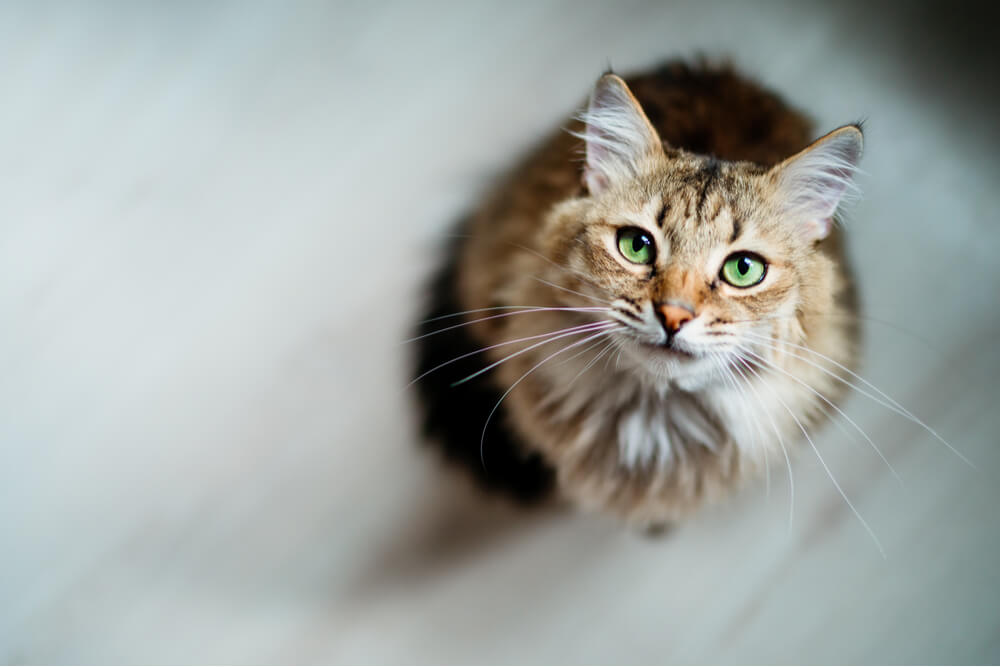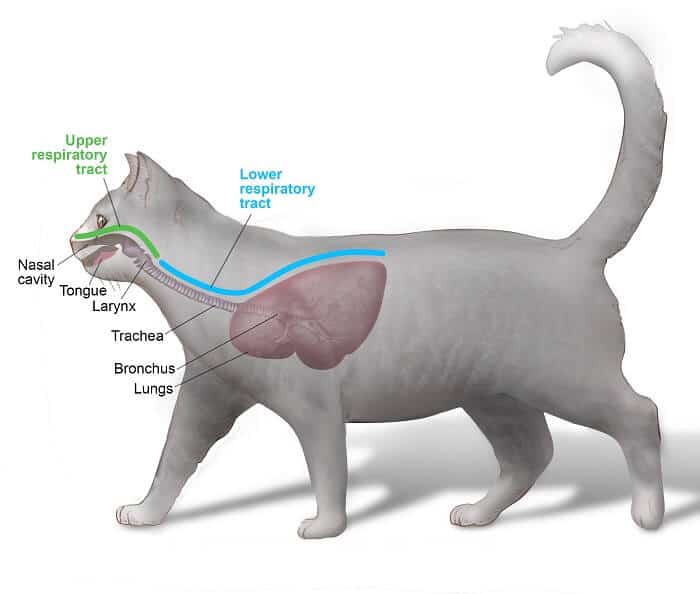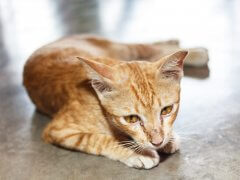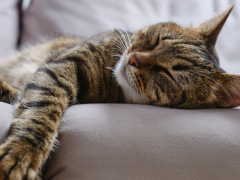Upper respiratory infections (URIs) are common in cats, especially among cats housed closely together in such environments as animal shelters, breeding catteries, and boarding facilities. Cat URIs are also common among ferals living in large groups outdoors (feral cat colonies).
Quick Overview: Upper Respiratory Infection (Chlamydia) In Cats
What Are Cat Upper Respiratory Infections?
Cats can develop infections of either the upper or lower respiratory tract. Feline URIs affect the nasal passages, sinuses, oral cavity, pharynx, and larynx (voice box).
Feline lower respiratory infections affect the trachea, bronchi, and lungs. Cats with URIs may also experience lower respiratory infections.
View below the diagram of a cat’s upper and lower respiratory tracts, provided by Cornell Feline Health Center.
What Causes Cat Upper Respiratory Infections?
URIs in cats occur when a contagious virus, bacteria, or fungus enters the cat’s body, causing an infection in one or more regions of the upper respiratory tract.
Cats may contract viral infections or bacterial infections from direct contact with other infected cats, or from contaminated items in the environment like food bowls and water dishes, litter boxes, bedding, and toys. Cats may pick up fungal infections when they go outdoors.
Sometimes, a cat that initially has a viral infection may develop a secondary bacterial infection. The initial viral infection weakens the immune system, making it easy for bacteria that are usually harmless to cause an infection.
Many different pathogens can cause URIs in cats. Some of the most common include:
Feline Herpesvirus (FHV-1)
Almost all cats will be exposed to feline herpesvirus at some point during their lives. Kittens are most at risk for becoming ill. Feline herpesvirus causes URIs as well as fever and corneal ulcers.
Feline herpesvirus type 1 is cited as being responsible for as many as 80% to 90% of all infectious feline upper respiratory diseases. A vaccine is available for feline herpesvirus (part of a combination vaccine that also protects against feline calicivirus and feline panleukopenia virus).
The vaccine is a core vaccine, meaning that it is required for all cats.
Feline Calicivirus (FCV)
This virus is extremely common and highly contagious. Most cats with feline calicivirus experience upper respiratory symptoms, but some go on to develop lower respiratory symptoms, including viral pneumonia.
A vaccine is available for feline calicivirus (part of a combination vaccine that also protects against feline herpesvirus and feline panleukopenia virus). This vaccine is a core vaccine.
Chlamydophila felis (C. felis)
This bacterium (which was formerly known as Chlamydia psittaci var felis) mainly causes conjunctivitis, which is inflammation of the conjunctiva (mucous membranes found on the eye and eyelid), and eye discharge. Chlamydophila more commonly affects kittens and young cats.
A vaccine is available but is not a core (required) vaccine for cats. Rather, it is recommended in specific situations, such as a multi-cat household or other environments in which cats live close together (e.g., breeding cattery).
Bordetella
Cats exposed to the bacterium Bordetella bronchiseptica may develop URIs. A vaccine is available for B. bronchiseptica but is a non-core vaccine. The vaccine might be recommended for cats that are at high risk of contracting the disease. A Bordetella infection is uncommon in pet cats.
Fungal Infections
Although a variety of fungi can cause respiratory infections in cats, the most common culprit is Cryptococcus neoformans. Cats that inhale the spores of this fungus may experience symptoms of both the upper and lower respiratory tract. Other fungi, such as Aspergillus fumigatus, Histoplasma capsulatum, and Blastomyces dermatiditis, generally cause lower respiratory symptoms like pneumonia.
Symptoms of Cat Upper Respiratory Infections
The symptoms of a feline upper respiratory infection resemble those of a human cold or flu, including coughing, sneezing, eye inflammation, lethargy, and more.
Cats with upper respiratory infections may have one or more of the following clinical signs:
- Coughing
- Sneezing
- Nasal congestion
- Nasal discharge (runny nose; may be clear or cloudy)
- Eye discharge (clear or cloudy)
- Conjunctivitis
- Blepharospasm (excessive squinting)
- Mouth ulcers
- Hoarse voice (meow sounds strange)
- Fever
- Lethargy (lack of energy, excessive sleeping)
- Anorexia (loss of appetite)
- Enlarged lymph nodes
Cats with upper respiratory symptoms may also experience one or more of the following symptoms of lower respiratory tract infection:
- Coughing
- Cyanosis (blue or gray lips, gums, and mouth)
- Difficulty breathing (shallow, labored, or rapid breathing)
Treatment & Recovery
The treatment of a cat upper respiratory infection depends on the infection’s origins and symptoms.
Treatment for a URI depends on what caused the infection and what symptoms the cat is experiencing. Depending on how sick the cat is, the cat might need only medications given at home, or require medications and in-hospital supportive care like fluids and nutritional therapy.
In general, URIs in cats may be treated with some of the following:
- Antibiotics
- Corticosteroids
- Nonsteroidal anti-inflammatory drugs
- Antiviral medications
- Anti-fungal drugs
- Intravenous or subcutaneous fluids
- Nasal decongestants
- Nutritional support
The cat’s prognosis depends on what caused the URI. In general, cats with mild to moderate URIs respond well to swift veterinary treatment.
URIs in cats can be caused by many different pathogens, so treatment is dependent on what is causing the infection, whether it be a virus, bacterium, or fungus.
For that reason, it’s important to seek veterinary care if your cat displays any symptoms of a respiratory infection. Do not attempt to treat your cat with home remedies or use any medication without explicit guidance from your veterinarian.
Frequently Asked Questions
What can I give my cat for an upper respiratory infection?
If your cat's URI was caused by something contagious, your veterinarian will instruct you to keep your cat separated from other cats until the symptoms are gone. Your vet will also tell you to thoroughly clean and disinfect your cat's living areas, food and water bowls, litter boxes, bedding, and other washable items with a diluted bleach solution.
How long does it take for a cat to get over an upper respiratory infection?
With appropriate and prompt veterinary treatment, viral and bacterial URIs generally clear up within days to weeks. Fungal infections may be trickier to treat. In some cases, treatment for fungal infections might last months. In the case of URIs caused by feline herpesvirus, the virus remains in the body for the rest of the cat’s life, and cats may experience occasional flare-ups of recurrent URIs.
Can an upper respiratory infection kill a cat?
URIs can be mild or serious. Some URIs lead to lower respiratory tract infections, including pneumonia, which can be life-threatening. Even without pneumonia, cats can become extremely sick or even die from a URI, especially if the cat is not eating or drinking enough. Never delay seeking veterinary treatment if your cat is exhibiting any signs of a respiratory infection.
Can feline upper respiratory infection spread to humans?
The most common viruses and bacteria that cause feline upper respiratory infections cannot infect humans, so in general, cats cannot pass respiratory infections to humans.












Our Maine coon cat has asthma and have been giving him steroid cream in his ear but does not seem to help much. Vet has been giving him steroid shots but do not last more than about a week and last shot did not seem to help much at all. Has been bad today coughing and breathing is bad and through his mouth. We have the steroid pills but will not take them and he gets vary aggressive. Also have the steroid liquid but will not take that without a fight and he bit me about three months ago trying to give him the liquid and when he bit he hit a tendon and its still vary pain full. Our cat is about 12 years old and is vary bad today as he is now not eating our drinking any water. Wife and i are vary devastated. Any help PLEASE.
Hi David, apologies for the late reply. Unfortunately, I can’t give much advice as I’m not a vet, nor do I know your cat’s full medical history. It’s difficult to say exactly what’s gone wrong or why your cat has been struggling so much recently. This vet-written article on asthma in cats may help. All the best to you, your wife, and your cat. – Mallory